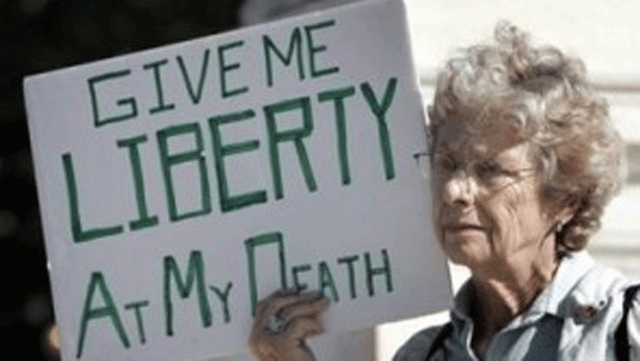Euthanasia, the easier word for doctor assisted suicide, is coming. What once seemed an unthinkable thought is now becoming normalized in many states and nations. The argument is that people should be autonomous and decide for themselves when it is time to die.
The culture of death has been hard at work for some time. Although many Americans oppose abortion, they have come to accept it, we have become accustom to abortion. It has taken decades but we now believe that a woman has a right to kill her own child.
Now the push is being made to make assisted suicide acceptable.
According to a Newsweek article, in the Netherlands in 2013 4,829 people took their own lives with the help of a doctor. That’s more than triple the number of people who committed suicide in 2002.
In the article, Winston Ross interviewed a 65 year old woman from Amsterdam named Jannie Willemsen who is currently in good health but has already prepared papers that define the conditions under which she does not want to live.
“I’m an autonomous person,” Willemsen says. “For me, it seems a disaster not to be able to go out and visit friends, to a concert, to the theater.”
While it is still technically illegal to have a doctor help you take your life in the Netherlands for mundane reasons, the Dutch government treats the crime much like pot use. People can choose to end their lives if they can convince two doctors that they are “suffering”.
This can include various medical condition or even emotional suffering such as loneliness. In the Netherlands you can have a doctor assist you in dying if you are tired of living. The Dutch have an unrestricted right to die.
This phenomenon is making its way to American shores too.
On February 6, the Supreme Court of Canada struck down a ban on physician-assisted suicide, joining Luxembourg, Belgium and Switzerland on the list of Western countries where euthanasia is fully legal. Switzerland has allowed assisted suicide since 1942, so long as patients “participate” in the administration of life-ending drugs (by ingesting them).
The scope of the Canadian judicial fiat is not limited to the terminally ill: The ruling grants competent adults a right to die if they have an “illness, disease, or disability that causes enduring suffering that is intolerable to the individual,” including “psychological” pain.
But here’s the kicker. The Canadians will ultimately require physicians to assist a patient in dying even if it violates a doctor’s deeply held beliefs. Does this sound familiar somehow? It should.
Remember the florist in Washington state who is being persecuted, I mean prosecuted for not providing flowers for a same sex marriage due to her Christian values? The courts are finding that you must serve people even if it violates your beliefs.
Lest we forget, the state of New Mexico may soon join the ranks of the Canadians and the Dutch. The New Mexico Court of Appeals is deciding the case of Aja Riggs, who was diagnosed with uterine cancer and is currently in remission. She would like the right to die should the cancer return.
She may get that right too. After all, the New Mexico court also found that a photographer did not have the right to refuse to photograph a gay commitment ceremony regardless of the photographer’s religious beliefs. It is not a leap in logic to assume that if the courts find a right to die in between the letters of the state’s constitution that the same court might find an obligation for doctors to kill people in violation of their beliefs, religious or not.
Godless courts across the country are destroying the United States constitution, especially the first amendment’s religious freedom in favor of the rights to commit murder and sexual immorality, while America sleeps.
Resource articles:
Dying Dutch: Euthanasia Spreads Across Europe, Newsweek (Winston Ross)
Euthanasia Comes to Canada, Weekly Standard (Wesley J. Smith)
